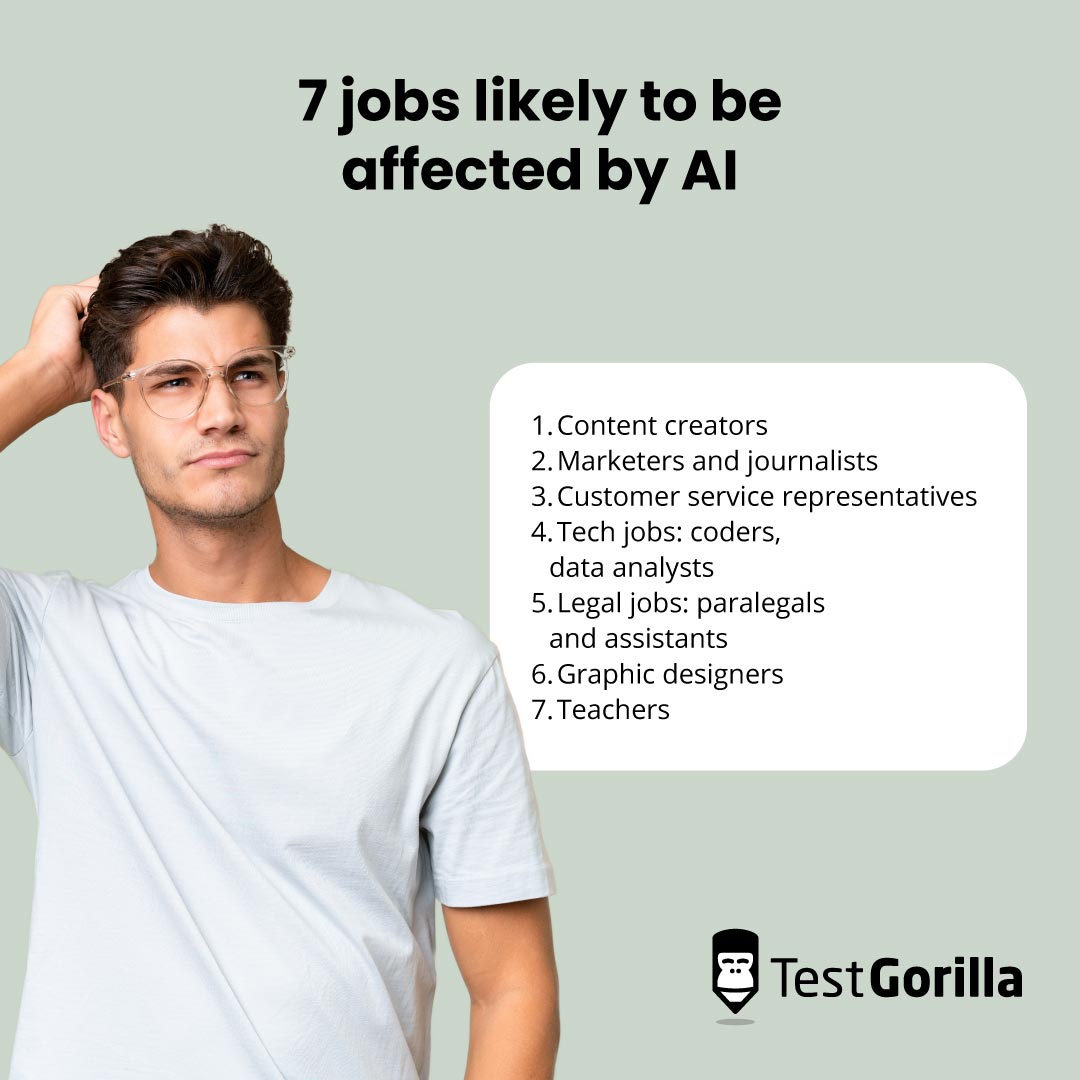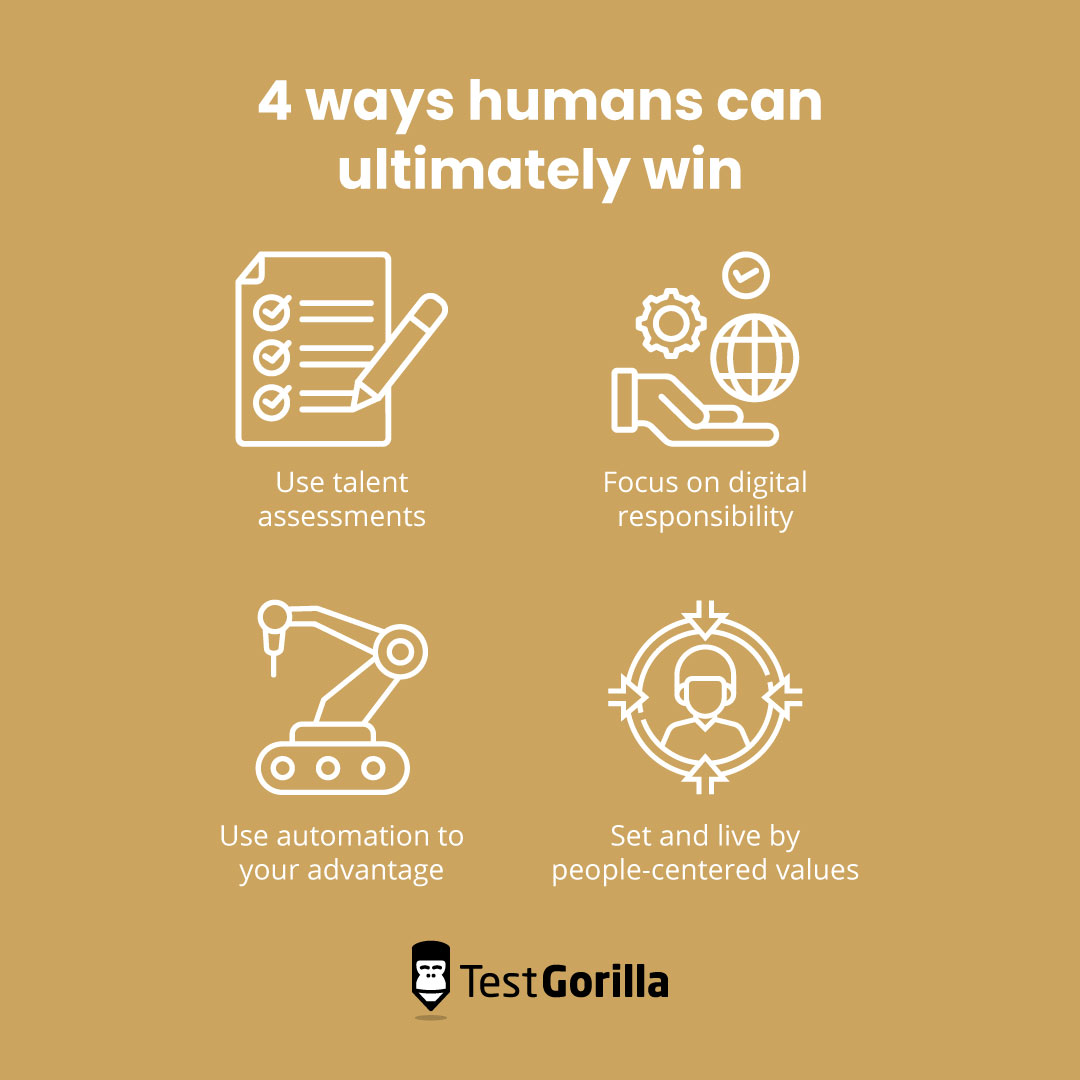Imagining a world run by artificial intelligence (AI) doesn’t seem so far-fetched anymore. We have self-driving cars, chatbots handling customer complaints, and smart devices safeguarding our homes.
However, while AI makes some aspects of our lives more efficient, it also raises concerns about the future of certain roles and industries. In this article, we explore the jobs most likely to be affected by next-generation AI tools. We also look at how people can adapt by learning new skills and embracing uniquely human qualities like creativity and critical thinking.
Finally, we show you how you can best support employees in the age of automation by using talent assessments to identify skills gaps. That way, you can help your people develop the skills they’ll need to keep up with new job demands and expectations.
Table of contents
7 jobs likely to be affected by AI
The rise of ChatGPT has had people scrambling to understand what generative AI means for the future of work.
So far, ChatGPT has aced the Arizona bar exam with a score nearing the 90th percentile. ChatGPT4 passed the Introductory Sommelier, Certified Sommelier, and Advanced Sommelier exams with flying colors.[1] Meanwhile, Google has claimed the language processing tool could qualify for an entry-level coding role if it were to interview at the company.[2]
Goldman Sachs predicts that a total of 300 million full-time jobs could be lost from this fast-growing technology, due to its ability to “generate content that is indistinguishable from human-created output and to break down communication barriers between humans and machines.”[3]
Even if it doesn’t dominate the entire job market, AI will undeniably affect many professions. Researchers from OpenAI and the University of Pennsylvania predict that large language models could influence at least 10% of work tasks for up to 80% of the US labor force.[4]
Let’s take a look at seven of the jobs most likely to be affected.
Content creators
AI models like ChatGPT have already made their mark on content creation with their ability to create human-sounding text. These tools can write blog articles, produce social media posts, generate topic ideas, and suggest improvements to text that has already been written.
Even though AI can produce content, it lacks the creativity and unique viewpoints that only humans can provide. Content creation often requires a deep understanding of the target audience, emotional intelligence, and the ability to evoke a connection with readers.
"We’re dealing with an alien intelligence that’s capable of astonishing feats, but not in the manner of the human mind," Harvard psychologist Steven Pinker told the Harvard Gazette. “We don’t need to be exposed to half a trillion words of text (which, at three words a second, eight hours a day, would take 15,000 years) in order to speak or to solve problems”.
Human content creators excel in bringing their unique perspectives, experiences, and storytelling abilities into their work. This lets them create content that resonates with readers on a deeper level than anything a machine could write.
To harness the power of AI, content creators can use these tools to help them think of ideas and overcome writer’s block at the early stages of the writing process. For example, by feeding ChatGPT the title of an article, they can get a suggested outline or even an introduction to use as a jumping-off point. They can also use AI tools built specifically for content creation, like Jasper.ai, Copy.ai, Wordtune, Copysmith, or Anyword.
Then, to stay one step ahead of language models, content creators should focus on developing their human skills of creative thinking, personalization, and storytelling.
Marketers and journalists
AI’s impact on journalism got off to a rocky start. Back in January 2023, CNET issued corrections in 41 of their 71 AI-generated articles.[5] One of these articles, which discusses the process of closing a bank account, included a correction note suggesting potential plagiarism.
The impact goes even further: In April 2023, the Guardian reported that ChatGPT was creating fake stories under the names of their journalists.[6]
However, if there’s one place in the communications field where AI excels, it’s copy, which is a major part of both journalism and marketing. Tools like ChatGPT can help craft engaging headlines, catchy one-liners, and witty taglines.
Language models are still significantly limited by their inability to fact-check efficiently, providing inaccurate citations in many cases and presenting concerns for the field of journalism. This means journalists and marketers need to focus on upskilling their critical thinking and fact-checking to make these tools work for them.
“You can ask it to provide an essay, to produce a story with citations, but more often than not, the citations are just made up. That’s a known failure of ChatGPT, and honestly, we do not know how to fix that.”
Chinmay Hegde, computer and electrical engineering associate professor at New York University.
Customer service representatives
How often have you contacted a company’s customer service only to get a response from a robot?
Gartner predicts that approximately 25% of companies will adopt chatbots as their primary customer service channel by 2027. Language models can engage in lifelike conversations and even cater to individual concerns, revolutionizing customer service automation.
While AI excels at handling simple client issues, it falls short in matching human intelligence and fostering genuine human connection. When faced with complex and emotionally-charged concerns, human support agents can use active listening skills and empathy to outshine their robot counterparts.
Additionally, unlike AI customer support, which relies on pre-existing data, human agents can constantly learn from their mistakes, navigate new situations, and provide innovative solutions to complex customer queries.
Tech jobs: Coders, data analysts
The demand for coding and computer programming skills remains high. However, experts like Lawrence Katz, a labor economist at Harvard, argue that AI technologies can potentially displace multiple tech roles, ranging from coders to data analysts.
Large language models excel in processing and analyzing data accurately. They have the ability to generate code faster than humans, leading to the potential to complete projects with fewer employees. Tech companies, including OpenAI, the creator of ChatGPT, are already exploring the idea of replacing software engineers with AI.
By using basic instructions, non-programmers can even use ChatGPT to create a twitter bot, website, or app from scratch without any coding knowledge.
To get AI working to their advantage, programmers can use it to enhance their own coding and programming skills. Engineers put tools like ChatGPT to work by using them to increase coding speeds, lower resource costs, and improve both individual and team efficiency.
Legal jobs: Paralegals and assistants
The legal industry runs on extensive information processing. Lawyers, paralegals, and their assistants need to understand and summarize laws, as well as create concise legal briefs and arguments. The structured nature of legal data and its reliance on language make it compatible with generative AI.
US company DoNotPay, which claims to be the world’s first robot lawyer, uses AI to contest parking tickets and pursue consumer-related legal cases through its app. The chatbot guides users through a questionnaire, helping them generate the required documents to take legal action.
AI-powered large language models have also found their way onto the London legal scene. The international law firm Allen & Overy recently introduced an AI chatbot named Harvey to help lawyers draft contracts and prepare documents for mergers and acquisitions.[7]
Despite these innovations, it’s unlikely that legal jobs will be completely taken over by AI. This is partly because these roles require human judgment to understand the specific needs and preferences of clients. There’s also the need for a physical human presence at many stages of the legal process, from visiting a client who has been arrested to defending them in court.
In sum, Lawyers and paralegals can make the best use of AI tools in the drafting of legal documents (always with the caution of inaccurate AI-generated information).
“Bias, the potential for plagiarism, the possibility of even unintentional inaccuracy – due to incomplete information entered into or instructions given to the system – are ever-present risks. Without control over the processes being maintained, overconfidence in the AI system could cause more damage than the anticipated benefits.”
Angelo Anglani, Commissioner for the IBA Future of Legal Services Commission and equity partner at ADVANT Nctm
Graphic designers
In 2021, OpenAI, the developer behind ChatGPT, introduced another tool called DALL-E, which generates customized images based on user prompts. Along with similar tools like Craiyon, Stable Diffusion, and Midjourney, this technology is generating anxiety among graphic and creative design professionals.
Pengcheng Shi, an associate dean in the Department of Computing and Information Sciences at the Rochester Institute of Technology, recently experimented with DALL-E. He asked the tool to generate a cubist portrait of rabbits for the Lunar New Year and was impressed with the outcome.
However, Shi observed a limitation in the technology when it came to replicating nuanced techniques. “I also asked it to do Matisse-style. It was not as good,” he told the New York Post.[8]
Apart from creative challenges, image-based AI tools also raise copyright concerns. Getty Images recently took legal action against Stability AI, the parent company of Stable Diffusion, alleging that the program unlawfully copied and processed millions of copyrighted images.[9]
While AI tools won’t replace designers, they can use them to their advantage. Much like marketers and content creators, graphic designers can use DALL-E and similar software to get their ideas flowing when facing a creative block.
Teachers
Teachers across the US are expressing concerns about students turning to ChatGPT to do their work for them, resulting in academic dishonesty. However, according to Pengcheng Shi, they should also be worried about their jobs.
He says that ChatGPT is already capable of effectively conducting classes – for example, an AI tutor can identify a student's weaknesses in math and then provide personalized lessons and practice problems designed to bridge these gaps.
However, integrating AI into education raises questions about human interactions and the role of teachers, as well as the danger of bias in AI-generated learning materials. To use it to their advantage, teachers can harness AI to help design lesson plans, ideate unique activities for their students, and create other student materials like worksheets and study guides.
4 ways that humans can ultimately win
Automation brings many benefits to the table, but it also raises concerns about job displacement and even harm to diversity and inclusion (D&I). When job cuts and layoffs roll around, underrepresented employees are often the first affected.[10] That means D&I may fall by the wayside when eliminating roles due to AI.
In the age of AI and the risks it presents to certain roles, companies should employ skills-based hiring to find the best candidates and protect diversity.
Traditionally, hiring decisions are based on credentials and experience. However, in the face of automation, the focus is shifting toward evaluating candidates based on their skill sets, potential, and adaptability. By embracing skills-based hiring, HR teams can tap into a wider pool of talent, uncover hidden potential, and foster diversity in their workforce.
Moreover, skills-based hiring serves as a strategic advantage for organizations. It allows recruiters to identify individuals who possess the aptitude to thrive in an evolving world.
Here’s how.
1. Use talent assessments
Use talent assessments to identify skills gaps and help your employees develop the knowledge and abilities to stay up to date on the latest AI technology.
By understanding the strengths and weaknesses of your team, you can create specific training programs and provide the support needed to fill those gaps. This keeps employees up-to-date and adaptable in a technology-led world.
Talent assessments help individuals unlock their full potential, align their skills with the evolving demands of jobs, and improve their chances of career growth. It's a smart way for businesses to stay ahead and ensure their employees thrive in the age of AI.
2. Focus on digital responsibility
As AI becomes more prevalent, humans will need to address the ethical and social implications tied to its use.
Hold discussions on digital responsibility, including issues like data privacy and algorithmic bias. Upholding transparency, accountability, and fairness in AI systems can lower potential risks and ensure you use them in a valuable and ethical way.
For example, when Weleda implemented a robotics process automation program, its executives took great care to ensure it didn’t lead to job losses and violate their core value of fair treatment.
Furthermore, some companies, like Merck, have established a digital ethics board to address complex issues related to data usage, algorithms, and digital innovations in areas like drug discovery and cancer research.
By incorporating digital responsibility into your practices, you can help your people use AI responsibly and ensure it’s working for your team, not against it.
3. Use automation to your advantage
Instead of fearing automation, embrace it and leverage its potential to increase productivity. Training employees on how to effectively use new tools, including large language models like ChatGPT, can help them learn how to use it in their day-to-day to be more efficient and spend less time on mundane tasks.
Therefore, encourage your employees to explore the capabilities of AI and provide them with the resources and time they need to interact with these technologies and see them as valuable tools.
A shift like this can lead to innovative problem-solving, streamlined processes, and improved decision-making, ultimately driving more success at your organization.
4. Set and live by people-centered values
In the face of advancing AI capabilities, emphasize and uphold human-centric values that set us apart from machines.
Kindness, respect, empathy, and active listening are necessary to foster meaningful relationships, collaboration, and creativity. These values are uniquely human – no matter how well a machine can replicate understanding, only people can understand other people.
This is why these values provide a unique advantage for humans in various areas, including customer service, leadership, and interpersonal interactions.
By prioritizing people-centered values, you can create a supportive work environment that celebrates human strengths and promotes employee well-being. This human touch is essential for building trust, nurturing talent, and maintaining meaningful connections.
AI hasn’t taken over yet: Humans can win in the digital age
The swift takeover of AI has left many people wondering if they’ll be jobless and undervalued, and there’s no doubt we’re racing toward a more automated future. However, there is a solution — the power of lifelong learning, upskilling, and reskilling.
By embracing a mindset of continuous growth and adaptability, you can build a team with the right skills to thrive in this new era.
One way to do so is to recognize the importance of skills-based hiring. Focus on evaluating candidates based on their abilities, aptitudes, and potential for growth rather than simply relying on outdated credentials like their resume or where they went to school. This helps you find people with the right skills to adapt to new technology, as well as uphold human qualities that are essential to your team’s success, like communication and empathy.
Human success in the age of automation depends on our ability to embrace change, continuously learn, and cultivate the qualities that set us apart.
There’s no need to fear this technology – rather, we should seize the opportunities it presents. By doing so, you can help your employees make the most of AI tools and future-proof them, and your business, as AI becomes an even bigger part of our lives.
Want a winning strategy to stay ahead of the AI game? Discover how skills-based hiring can help you keep recruitment fair and find the right people for the job in an AI-powered world. Download the 2022 State of Skills-Based Hiring Report
Sources
“AI models like ChatGPT and GPT-4 are acing everything from the bar exam to AP Biology. Here's a list of difficult exams both AI versions have passed.”Business Insider, Accessed on June 27, 2023. https://www.businessinsider.com/list-here-are-the-exams-chatgpt-has-passed-so-far-2023-1
“Google is asking employees to test potential ChatGPT competitors, including a chatbot called ‘Apprentice Bard’,” CNBC, Accessed on June 10, 2023. https://www.cnbc.com/2023/01/31/google-testing-chatgpt-like-chatbot-apprentice-bard-with-employees.html
“The Potentially Large Effects of Artificial Intelligence on Economic Growth” (2023) Goldman Sacks Economics Research, Accessed on June 15, 2023. https://www.key4biz.it/wp-content/uploads/2023/03/Global-Economics-Analyst_-The-Potentially-Large-Effects-of-Artificial-Intelligence-on-Economic-Growth-Briggs_Kodnani.pdf
“GPTs are GPTs: An Early Look at the Labor Market Impact Potential of Large Language Models,” OpenAI, OpenResearch, and University of Pennsylvania, Accessed on June 10, 2023. https://arxiv.org/pdf/2303.10130.pdf
“CNET Is Testing an AI Engine. Here's What We've Learned, Mistakes and All,” CNET, Accessed on June 13, 2023. https://www.cnet.com/tech/cnet-is-testing-an-ai-engine-heres-what-weve-learned-mistakes-and-all/
“ChatGPT is making up fake Guardian articles. Here’s how we’re responding”, The Guardian, Accessed on June 13, 2023. https://www.theguardian.com/commentisfree/2023/apr/06/ai-chatgpt-guardian-technology-risks-fake-article
Related posts
Hire the best candidates with TestGorilla
Create pre-employment assessments in minutes to screen candidates, save time, and hire the best talent.
Latest posts
The best advice in pre-employment testing, in your inbox.
No spam. Unsubscribe at any time.

Hire the best. No bias. No stress.
Our screening tests identify the best candidates and make your hiring decisions faster, easier, and bias-free.
Free resources
This checklist covers key features you should look for when choosing a skills testing platform
This resource will help you develop an onboarding checklist for new hires.
How to assess your candidates' attention to detail.
Learn how to get human resources certified through HRCI or SHRM.
Learn how you can improve the level of talent at your company.
Learn how CapitalT reduced hiring bias with online skills assessments.
Learn how to make the resume process more efficient and more effective.
Improve your hiring strategy with these 7 critical recruitment metrics.
Learn how Sukhi decreased time spent reviewing resumes by 83%!
Hire more efficiently with these hacks that 99% of recruiters aren't using.
Make a business case for diversity and inclusion initiatives with this data.



















